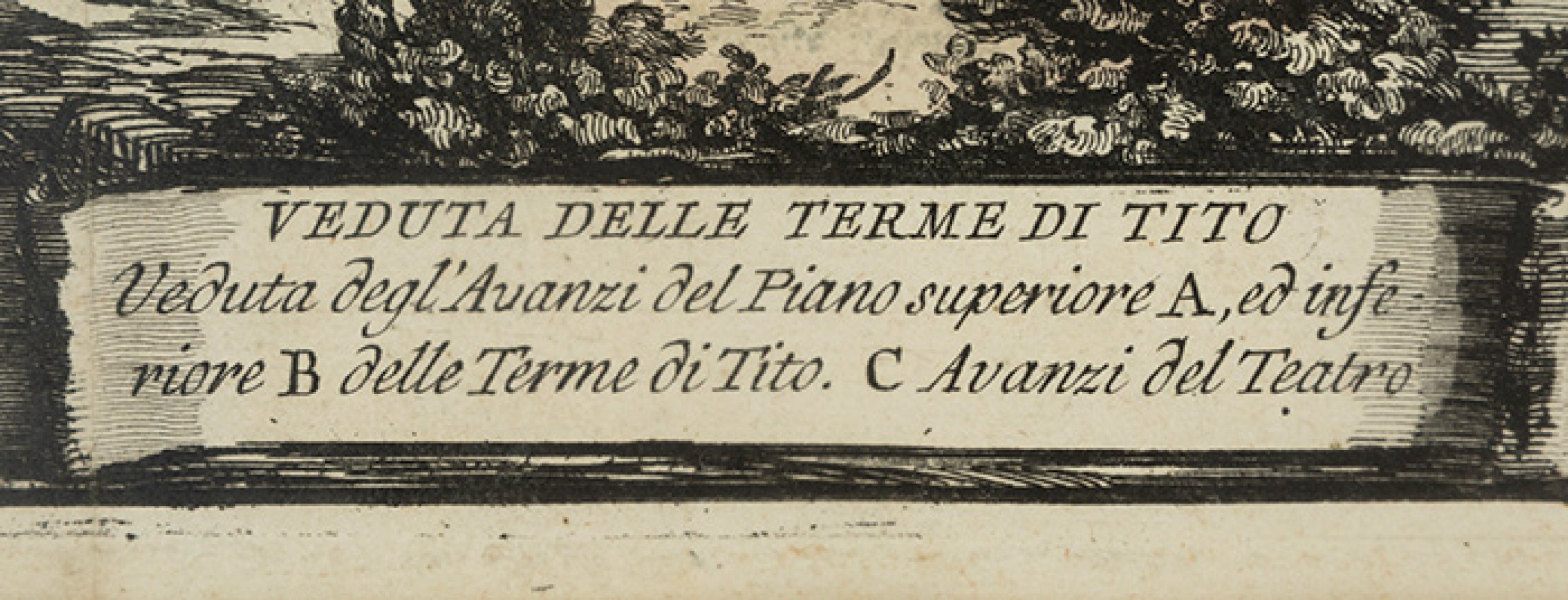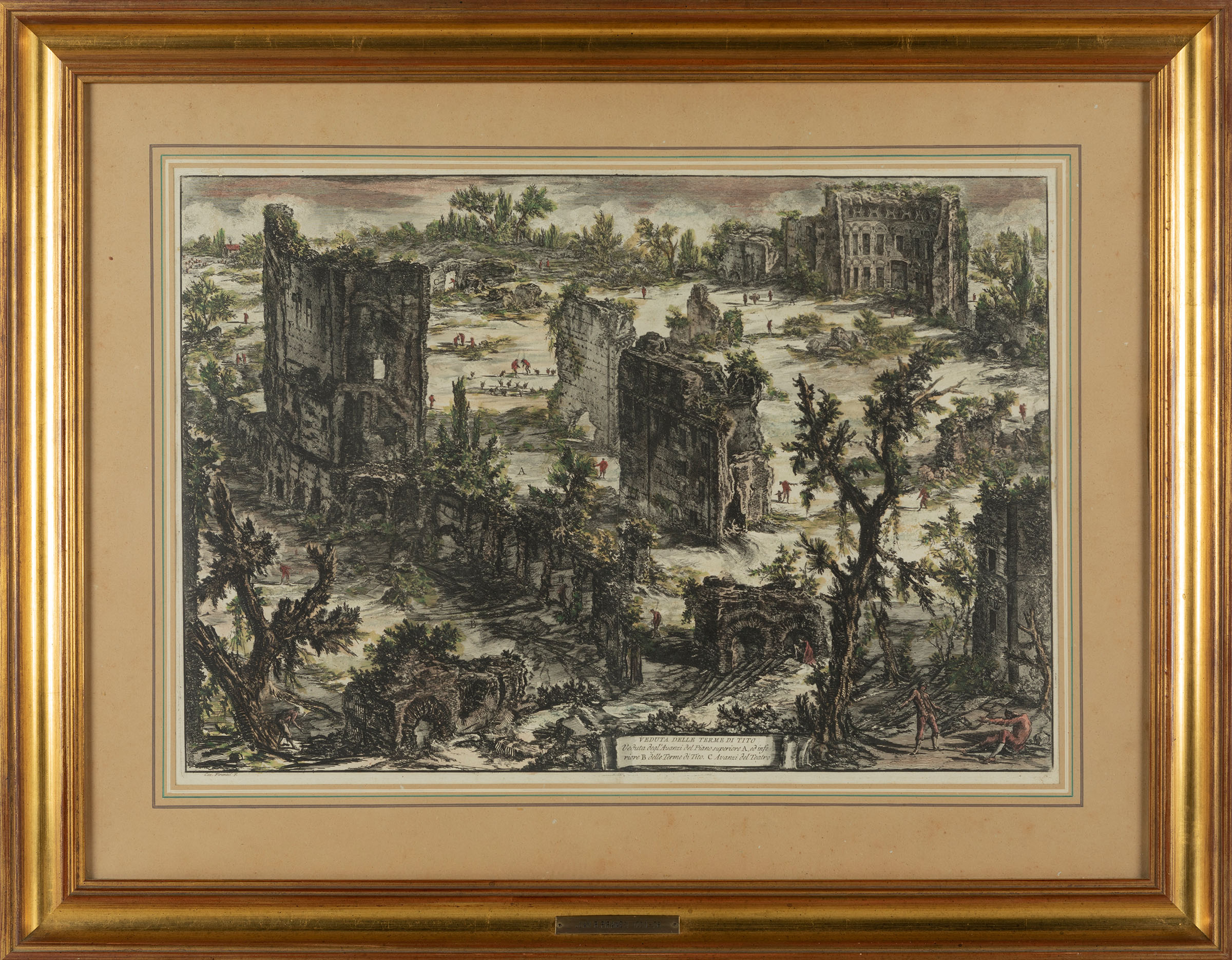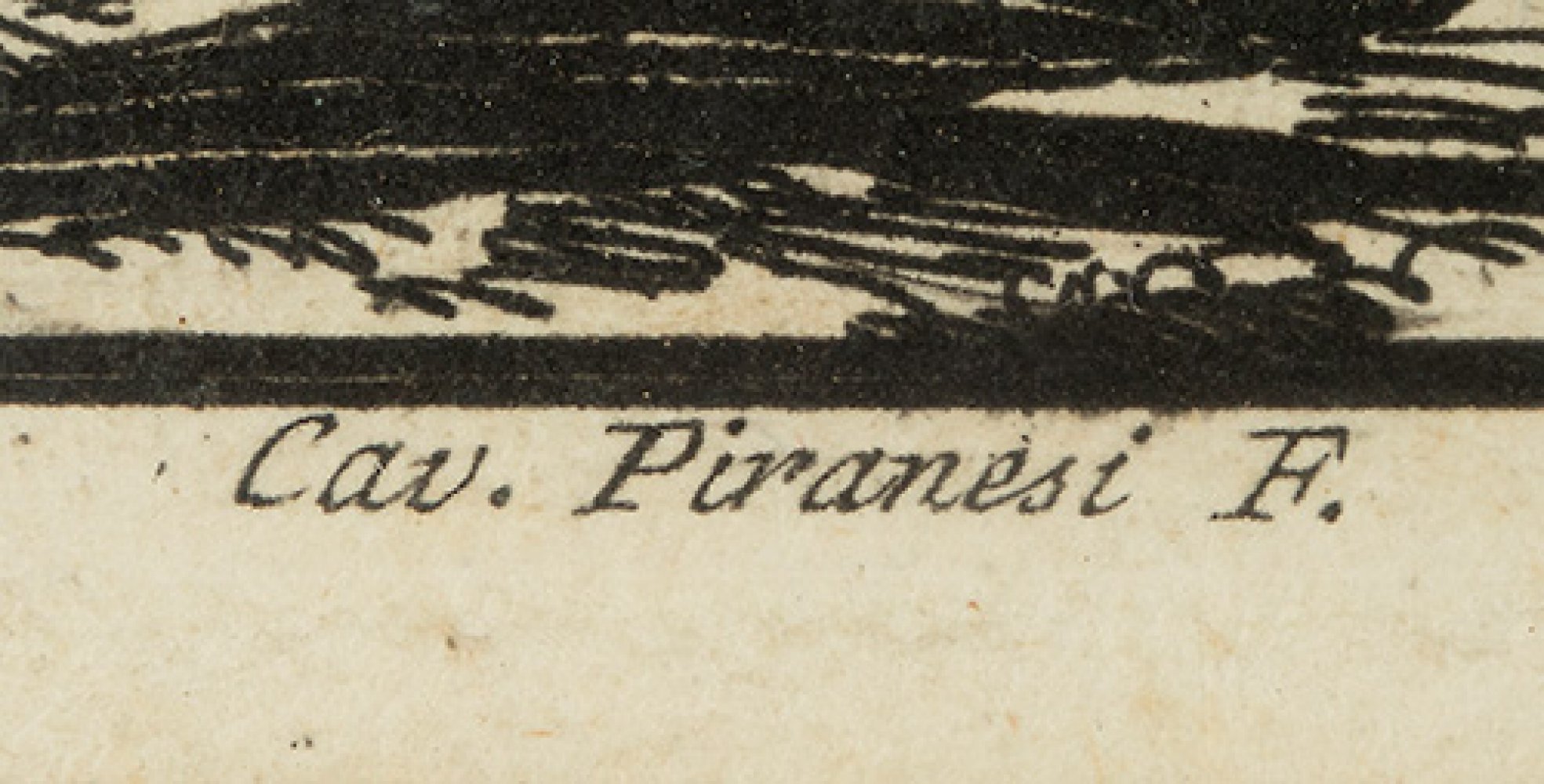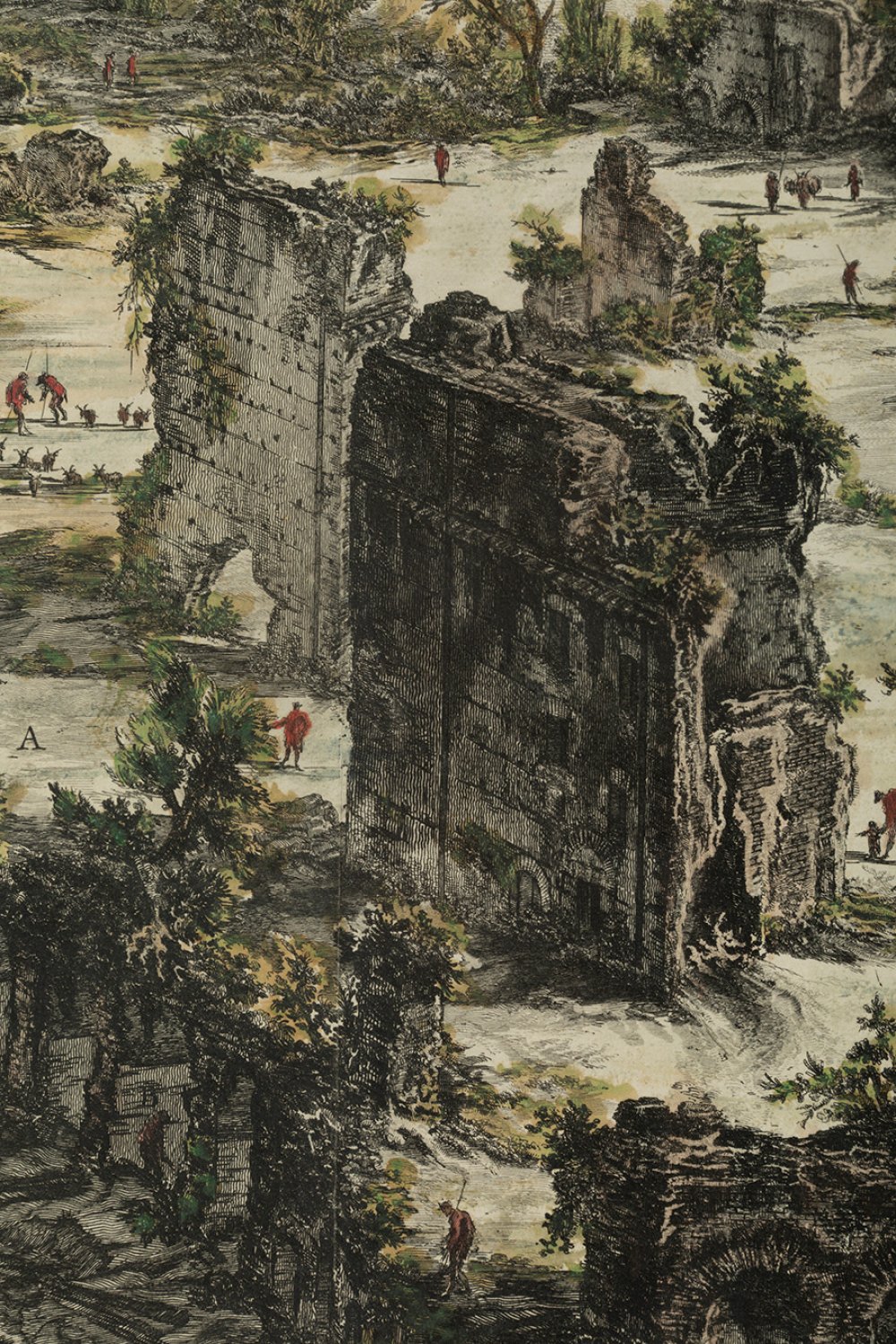18
GIOVANNI BATTISTA PIRANESI (Mogliano Veneto, 1720 - Rome, 1778)."Veduta delle Terme di Tito.
"Veduta delle Terme di Tito. Veduta degl'Avanzi del Piano superiore A, ed inferiore B delle Terme di Tito. C Avanzi del Teatro".
Etching engraving illuminated by hand.
Size: 49 x 72 cm (print); 50 x 73 cm (paper); 77 x 98 cm (frame).
Piranesi first arrived in Rome in 1740, and there he found an established market for selling views of the city as souvenirs of the Grand Tour. His Views, however, transcended topographical fidelity and became heroic and tragic visions of the power of Roman architecture. Piranesi's Venetian origins were decisive in this particular representation of the city; his training as an engineer and builder in stone (in the poetic effect of the ruin, for example), and his apprenticeship as a set designer (sensitivity to the effects of light and great skill in linear and atmospheric perspectives). The plates were printed and sold in single sheets or in collections, initially through his publishers, Bouchar and Gravier. Piranesi went to the former's establishment every evening to see which views sold best and to listen to the comments of the customers. In 1760, however, the artist opened his own establishment, in the Palazzo Tomati, and from then on took control of the entire business, from printing to sales. Over the next two decades he produced a large body of work, and after his death in 1778 the business only increased. His son Francesco Piranesi expanded his father's series of 135 plates by two, and continued to sell in Rome until 1799, when he settled in Paris. Francesco sold the first Paris edition between 1800 and 1807, and after his death in 1810 the plates were acquired by the house of Firmin-Didot, which continued to publish them between 1835 and 1839. After the latter date they were acquired by what is now the Royal Chalcography in Rome.
Piranesi was an Italian engraver who produced more than 2,000 engravings of real and imaginary buildings, as well as Roman statues and reliefs. He studied architecture in Venice with his uncle, Matteo Lucchesi, where he learned about the works of Palladio, Vitruvius and the buildings of antiquity. In 1740 he moved to Rome, accompanied by the Pope's envoy in Venice, Marco Foscarini. In the Italian capital he was impressed by the Roman ruins and focused on depicting them, combining descriptive zeal and fantasy in a style that advanced Romanticism by a hundred years. In Rome he learned the technique of etching, and in 1743 he published his first large series of prints, "Prima Parte di Architettura e Propettiva". At the age of just twenty-three Piranesi already revealed his mastery as an engraver and his inventiveness. He opened his workshop opposite the French Academy in Rome, so he was always in close contact with French artists and scholars. His engravings enjoyed great commercial success, as they were sold to travellers as souvenirs of the Eternal City. In 1761 he became a member of the Accademia di San Luca in Rome. Prints by Piranesi are preserved in the world's leading museums, including the Hermitage in St Petersburg, the Louvre, the Metropolitan Museum in New York, the Rijksmuseum in Amsterdam, the British Museum, and the Fine Arts Museums in Dallas, San Francisco, Detroit, Washington, Sydney and Montreal.
"Veduta delle Terme di Tito. Veduta degl'Avanzi del Piano superiore A, ed inferiore B delle Terme di Tito. C Avanzi del Teatro".
Etching engraving illuminated by hand.
Size: 49 x 72 cm (print); 50 x 73 cm (paper); 77 x 98 cm (frame).
Piranesi first arrived in Rome in 1740, and there he found an established market for selling views of the city as souvenirs of the Grand Tour. His Views, however, transcended topographical fidelity and became heroic and tragic visions of the power of Roman architecture. Piranesi's Venetian origins were decisive in this particular representation of the city; his training as an engineer and builder in stone (in the poetic effect of the ruin, for example), and his apprenticeship as a set designer (sensitivity to the effects of light and great skill in linear and atmospheric perspectives). The plates were printed and sold in single sheets or in collections, initially through his publishers, Bouchar and Gravier. Piranesi went to the former's establishment every evening to see which views sold best and to listen to the comments of the customers. In 1760, however, the artist opened his own establishment, in the Palazzo Tomati, and from then on took control of the entire business, from printing to sales. Over the next two decades he produced a large body of work, and after his death in 1778 the business only increased. His son Francesco Piranesi expanded his father's series of 135 plates by two, and continued to sell in Rome until 1799, when he settled in Paris. Francesco sold the first Paris edition between 1800 and 1807, and after his death in 1810 the plates were acquired by the house of Firmin-Didot, which continued to publish them between 1835 and 1839. After the latter date they were acquired by what is now the Royal Chalcography in Rome.
Piranesi was an Italian engraver who produced more than 2,000 engravings of real and imaginary buildings, as well as Roman statues and reliefs. He studied architecture in Venice with his uncle, Matteo Lucchesi, where he learned about the works of Palladio, Vitruvius and the buildings of antiquity. In 1740 he moved to Rome, accompanied by the Pope's envoy in Venice, Marco Foscarini. In the Italian capital he was impressed by the Roman ruins and focused on depicting them, combining descriptive zeal and fantasy in a style that advanced Romanticism by a hundred years. In Rome he learned the technique of etching, and in 1743 he published his first large series of prints, "Prima Parte di Architettura e Propettiva". At the age of just twenty-three Piranesi already revealed his mastery as an engraver and his inventiveness. He opened his workshop opposite the French Academy in Rome, so he was always in close contact with French artists and scholars. His engravings enjoyed great commercial success, as they were sold to travellers as souvenirs of the Eternal City. In 1761 he became a member of the Accademia di San Luca in Rome. Prints by Piranesi are preserved in the world's leading museums, including the Hermitage in St Petersburg, the Louvre, the Metropolitan Museum in New York, the Rijksmuseum in Amsterdam, the British Museum, and the Fine Arts Museums in Dallas, San Francisco, Detroit, Washington, Sydney and Montreal.
7th September - Old Masters
Sale Date(s)
Venue Address
General delivery information available from the auctioneer
Setdart offers Worldwide shipping
PICK UP IN ROOM: You can come and pick up your lots in our offices (Barcelona, Madrid or Valencia). At the moment of the withdrawal, you will be able to accept the current conditions of the lot by means of a document that you will sign.
YOU CAN SEND ANOTHER PERSON TO PICK UP: This person must present a signed authorization that you can find in our web page by accessing from BUY AT SETDART- LOGISTICS-DOWNLOAD AUTHORIZATION DOCUMENT. You can also send an e-mail with the requested data in AUTHORIZATION DOCUMENT to admin@setdart.com
Important Information
25% buyer´s premium
21% buyer´s premium at www.setdart.com
Terms & Conditions
The maximum period to pay the lots is 7 working days. You can pay either via bank transfer or with credit card through our platform www.setdart.com (we only accept VISA or Mastercard).
BUYER´S PREMIUM: 22% Hammer price + 21% VAT from the buyer´s premium
If your piece has more than 100 years, our Ministry of Culture requires an export certificate in order for the piece to leave the country. Note that if the piece goes inside the EU, there is no cost for the export certificate. If the piece goes outside the EU, there is a cost for the export certificate. You can find more information in our Ministry of Culture website: https://www.culturaydeporte.gob.es/en/cultura/patrimonio/exportacionimportacion/exportacion/tasas.html
INQUIRIES: admin@setdart.com
Setdart guides you through the entire process, from the time of award to the day you receive your lot. Our logistics team will be happy to manage your transport, and will advise you on the best shipping method with professionals from the sector used to handling works of art and jewelry.
WE OFFER WORLDWIDE DOOR TO DOOR SHIPPING
PICK UP IN ROOM: You can come and pick up your lots in our offices. At the moment of the withdrawal, you will be able to accept the current conditions of the lot by means of a document that you will sign.
YOU CAN SEND ANOTHER PERSON TO PICK UP: This person must present a signed authorization that you can find in our web page by accessing from BUY AT SETDART-LOGISTICS-DOWNLOAD AUTHORIZATION DOCUMENT. You can also send an e-mail with the requested data in AUTHORIZATION DOCUMENT to admin@setdart.com
SETDART IS NOT RESPONSIBLE FOR THE STATE OF THE PARTS ONCE THEY LEAVE OUR FACILITIES. MRW SHIPMENTS: Once the payment is made, your lot will be packed for shipment, the logistics department will send you an e-mail notifying you of the day it leaves our warehouse, changes of address cannot be made after receiving this e-mail.
INSURANCE INCIDENTS: Coverage for the value of the auction up to 3000 ? per shipment, if the value of the auction is higher, Setdart will send you a quote including the additional insurance. The insurance company WILL NOT BE RESPONSIBLE FOR THE SHIPMENT THAT EXCEEDS THAT AMOUNT AND IS NOT FULLY INSURED. MRW INCIDENTS: Maximum notification 48 hours after receipt, after which the insurance company WILL NOT BE RESPONSIBLE AND NO CLAIMS WILL BE ACCEPTED.
E-MAIL LOGISTICS: logistica@setdart.com
PICK UP YOUR MESSAGES: You can send your own messaging, prior notice via e-mail that your shipment is ready, please note 3 or 4 days in advance. This type of shipment is packaged so Setdart will provide you with a quote.
EXPENSES FOR STORAGE: We inform you that if the purchased lot is not picked up within a month, you will be charged 30€ per week per lot. Setdart Online S.L., owner of the web site "setdart.com", "setdart.net" and "setdart.org", acts as a company of Spanish nationality inscribed in the Volume 36955, sheet 182, page B-293056 of the Mercantile Registry, with registered office at Calle Aragó


















